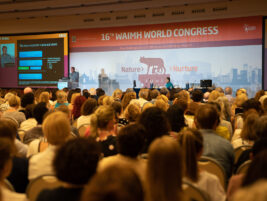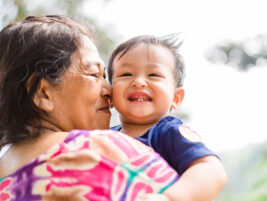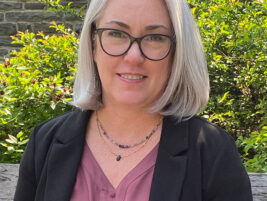This article was previously published in the Infant Crier, an open aource publication, and appears here with permission from the Michigan Association for Infant Mental Health.
“So, what is Reflective Supervision or Consultation, anyway?” I am asked, yet again. I take a deep breath and orient myself to whom I am speaking. A mental health clinician unfamiliar with early childhood mental health? Someone who offers early care, education, or support services of a different kind? Is it a program supervisor or administrator? Someone who is responsible for workforce development policy and who needs to know what value reflective practices, including supervision or consultation, can offer to their system? Is it a student or new staff person?
My answer will be slightly different for each of these individuals because they each come to that question from a unique place. However, a brief dilemma statement can help move the conversation forward to get a glimpse into what reflective supervision/ consultation (RS/C) is and how it might be important to enhancing the quality of service they offer.
Here are a few good ones:
- A new staff person appears uncomfortable speaking with a parent about their baby’s observable atypical development.
- An experienced staff person is having difficulty engaging a particular family.
- A clinician who has worked with older children and their families is now working in an infant mental health (IMH) program; she is observed picking up the baby to play when she walks into one of her families’ homes and launching into conversation with the parent about whether the agreed upon time for parent-infant play was spent since she was last there.
- An infant/toddler caregiver feels overwhelmed by a toddler who refuses to stop hurting other children in her care.
- A supervisor has a staff person who is extremely inconsistent in meeting with him
You might find yourself easily able to see how these dilemma statements could be used to engage in a dialogue that sheds light on how RS/C addresses the issues of relevance. Each of them is a real practice example of an opportunity to engage in mutual exploration, to clarify experiences and perspectives, and to uncover possibilities for further focus.
Let’s now consider aspects of RS/C that can inform any responses you might offer:
- What do we mean when we talk about RS/C?
- What do we mean when we talk about RS/C?
- Why do we believe it is so important to the provision of quality relationshipbased services to infants, toddlers, and families, as well as to the growth and health of the professional?
- How do we use this important relationship process to manage all that there is to balance?
In RS/C we try to balance:
- Attention to the self with attention to the work,
- Attention to the supervisory relationship, with the practitioner-family relationship, with the parent-baby relationship (to what each partner brings to those relationships), and the weird thing we call “parallel process” by which one influences all the others,
- Attention to what is there, what is missing, and to whether all perspectives are represented,
- Attention to emotions stimulated and to thoughts that emerge to be explored,
- Attention to noticing and holding the experience that is there, and also to help support openness to explore what we do not know yet.
What do we mean when we talk about RS/C?
Without citing the literature here, I will summarize by saying that it is a collaborative relationship for learning and support that requires true participation between supervisor and supervisee or consultant and consultee(s). Its most basic expectations are that it:
- Is safe and mutually respectful,
- Is consistent and frequent enough to create continuity and familiarity
- Pays attention to the emotional experience and thoughts of the supervisee,
- Pays attention to all of these relationships — supervisor and practitioner, practitioner and family, parent/caregiver and very young child,
- In addition to helping supervisees increase their understanding about a family or dilemma in their work, it provides a “holding environment” within which they can tolerate a bit of ambiguity (and sometimes anxiety or other difficult feelings) long enough to be curious, to be open, and to notice and explore what might be observed in the baby, caregiver, and self.
It may or may not be obvious, but BOTH supervisor and supervisee must be willing to engage in this way.
What are the core processes in RS/C?
We are learning to tease these apart now through various research efforts taking place across the country. Observable elements of RS/C are being codified in a tool under current development by Christopher Watson, Ph.D., along with colleagues at the University of Minnesota and others working in states who have purchased a license to use the MI-AIMH Endorsement ®. This tool, called the Reflective Interaction Observation Scale (RIOS), seems to capture the core processes quite well.
The first core process is the mutual attempt to Understand the Story that is being presented about the baby, family, and the work with them, in a way that looks beyond a superficial presentation and considers the influence of history and current contexts. A supervisor and supervisee hope to avoid rushing to judgment as they try to get the best handle on what is happening in order to figure out where they are and what to do next. This can be one of the hardest things to do in the push to solve the problem, allowing us to move away from the feeling of confusion or the discomfort of not knowing.
The ability to understand and use Parallel Process is another important element in RS/C. In IMH, we believe that the most therapeutic thing about what we do is the relationship we offer. We believe that this is true whether we are IMH practitioners acting as therapists or as IMH-informed practitioners working in other systems or disciplines. We hope that the quality of the relationship that the practitioner offers to the family is a new experience that can be taken in by the caregiver and the baby as a source of regulation, consistency, acceptance, appreciation, curiosity, etc., and that the caregiver, having been really seen in this way by the practitioner, will be more able to do this for their very young child.
How can a practitioner do this for a caregiver in a consistent, genuine way if they do not experience this “being seen” and accepted when vulnerable, when clear and strong, when sad or anxious, or when not knowing? Short answer, I do not think they can. The supervisor/consultant’s offer of this relationship to the supervisee makes it more possible for him or her to be with the caregiver and very young child in a unique way through this parallel process. It allows them to also use observations about the affective experience at the level of the supervisor and/or supervisee to tell them something about the affective experience of baby and family members.
This adds a layer of quality that goes above and beyond diagnostic formulation and carrying out well-designed treatment plans. This wondering about the effects of relationships upon relationships helps inform the work. The RS/C relationship should help the supervisee pay attention to his or herself in the work in order to increase use of self.
Holding the Baby in Mind is the next element. We all naturally tend to gravitate toward a particular interactive partner in our observations and perspectives. When families or other caregivers are particularly overburdened, or supervisees are overwhelmed by worries, either in their own lives or in response to what the caregivers present, it is easy to lose sight of the baby. Is it too overwhelming to wonder how the baby experiences these things? Is it too sad or frightening? What does the baby bring to the equation? What does the baby mean to the caregiver?
The baby as an interactive partner tells us much about what is important in the work with a family. A supervisor/consultant may have to notice when there are little observations or curiosity about the baby in his/herself, or in the supervisee, and engage in gentle inquiry about this.
The Working Alliance is the term used to describe some of the other characteristics of great import to the RS/C process. This is something that has to be built. I think it starts most hopefully with assuming best intent of the other on the part of both supervisor and supervisee. This is easier said than done sometimes – because of past relationships or the lack of confidence of a new supervisor or of a new supervisee, or of mismatch in style, personality, training, or cultural expectations.
Just as is true in a new practitioner-family relationship, trust and safety have to be grown and tested in order for real comfort to emerge. A pair will have to negotiate how to set their agenda and goals, what the expectations of each other are, how to use their time, and ask for information. They will celebrate accomplishments. They will have to sort through many experiences — of observing and wondering together, of sitting with silence, of not knowing when the pressure to know feels urgent, or of inquiring about what might be missing. They will need to acknowledge their own feelings as they emerge in order to better understand what is happening in the work and be willing and able to manage intense feelings. They will have to learn how to repair when there are mis-attunements or misunderstandings and to learn and try out new skills. It is a developmental process for each supervisee and supervisor, for each RS/C relationship, and even within that, perhaps for each new type of dilemma.
Just as is true in a new practitioner-family relationship, trust and safety have to be grown and tested in order for real comfort to emerge. A pair will have to negotiate how to set their agenda and goals, what the expectations of each other are, how to use their time, and ask for information. They will celebrate accomplishments. They will have to sort through many experiences — of observing and wondering together, of sitting with silence, of not knowing when the pressure to know feels urgent, or of inquiring about what might be missing. They will need to acknowledge their own feelings as they emerge in order to better understand what is happening in the work and be willing and able to manage intense feelings. They will have to learn how to repair when there are mis-attunements or misunderstandings and to learn and try out new skills. It is a developmental process for each supervisee and supervisor, for each RS/C relationship, and even within that, perhaps for each new type of dilemma.
This is the vehicle for truly supported learning where relationship affects relationship, and where competencies — theory and knowledge and skills and reflection — can be tried out in a supported way. Supervisees do this with the help of the supervisor, parents and other caregivers do this with the help of the practitioner, and babies do this with the help of those who care for them. None of us learn from experience alone, rather it is the reflection on experience that teaches.
Reference
Watson, C., Gatti, S., Harrison, M., & Hennes, J. (2014). Reflective supervision and its impact on early childhood Intervention. In Advances in Early Education and Day Care: Early Childhood and Special Education, Vol. 18. (Eds. E. Nwokah & J. Sutterby). Emerald Group Publishing: United Kingdom. pp. 1-26.
Reflective supervision/consultation -What is it & why does it matter?
Authors
Goldberg, Sheryl,
LMSW, ACSW, IMH-E ®(IV),
sgoldberg@mi-aimh.org,
United States








